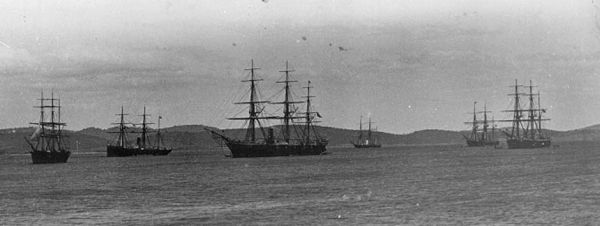 |
 |
|
Russians
The first official Russian visit took place in 1823 (Kreiser and Ladoga), followed by the Boyarin (1870), a Russian naval squadron (1882) and the Vestnik (1886). The Tasmanian Times and the Mercury devoted much attention to the Boyarin ('the best of ships of all the fleets of Europe'), while Adelaide papers abused the Russians. The number of 'unofficial' Russian visitors cannot be given with certainty. In 1823 Captain Lasarev reported that four Russians lived in Tasmania, one transported as a convict from England in 1804. The fifth resident became the ship's helmsman Stanislav Stankievitch, who jumped ship after an unsuccessful attempt at mutiny and joined the local bushmen. Four Russians left descriptions of their visits. ER Zimmerman (1881) came to Tasmania to study the history of colonisation with particular regard to the consequences of transportation, and the island's economic situation. LA Perre (1892), a mining engineer, studied methods of exploiting gold deposits. NA Kryukov (1902–03), a famous agricultural expert, investigated 'all aspects of the agriculture of the young Australian Federation'. C Balmont (1912), the famous poet-symbolist, gave public lectures about Tasmania upon his return home. In the twentieth century another category of Russians started coming to Tasmania – immigrants of the so-called 'first wave' working class/revolutionary immigration. By 1911 over forty were registered, but their actual number must have been much greater as the Okhranka (Russian Secret Police) kept an informer in Queenstown where they seem to have concentrated, and which might explain why from 1912 to 1917 there was in Hobart a Russian consul, Alfred Ashbolt. No documents concerning possible arrivals of the second wave, post-1917 to the mid-1930s, have been found, but in the 1950s there were about sixty Russian families living in Tasmania, some being descendents of the earlier settlers and the rest coming from post-war Germany. The latter were employed (under government contracts) in constructing roads on Bruny Island. In 2004 there were about 200 people who consider themselves still Russians, with 48 coming from 1996–2004 (author included). The total number of Russian origin descendants may reach 1100. The Church (Russian Orthodox) was and still is the main means of preserving 'Russian identity', as it happens all over the world and not because of a particular Russian religiousness. To illustrate the point: although the Ukrainian Association still exists in Tasmania, their Church does not; Russians made only a brief attempt at having their own association called 'Russian Settlers' (founded and presided by Mrs Guidi in 1980), but spare no effort at keeping the Church going. The lack of any other usual community activities is explained by the nature/character of the last waves of Russian immigration – people were fleeing from one huge Communist 'association' and any 'association' would always have a negative connotation for them. However, there is an association 'Tasmanian Friends of Russia', whose function is promoting links between Tasmania and Russia. Luda Kedova |
Copyright 2006, Centre for Tasmanian Historical Studies |
